In recent years, the concept of social media commerce has emerged as a powerful force. By combining the influence and reach of social media platforms with the convenience of online shopping, it is revolutionizing how businesses engage with their customers and sell products or services. In this article, we will talk about its benefits and how it differs from conventional e-commerce. We’ll also showcase businesses that have embraced social commerce platforms and discuss what makes respond.io a competitive social commerce platform.

What is Social Commerce?
Social commerce refers to the integration of social media and online shopping. It leverages the vast user base and engagement potential of social media platforms to facilitate the buying and selling of products or services directly within the social media environment.
Rather than redirecting users to external e-commerce websites, social commerce platforms offer seamless shopping experiences, allowing consumers to browse, compare, purchase and share their purchases without leaving the social media platform.
This term shouldn’t be mistaken for e-commerce. In the next section, we’ll discuss the differences between both terms.
Social Commerce vs E-commerce
Traditional e-commerce often involves multiple steps, from discovering a product to navigating through various pages before completing a purchase.
Unlike conventional e-commerce, which primarily relies on dedicated online stores or marketplaces, social commerce integrates shopping functionality directly into social media platforms.
This integration blurs the lines between social interaction and commercial transactions. By eliminating the need for users to navigate to external websites, the purchasing process becomes quicker and more convenient.
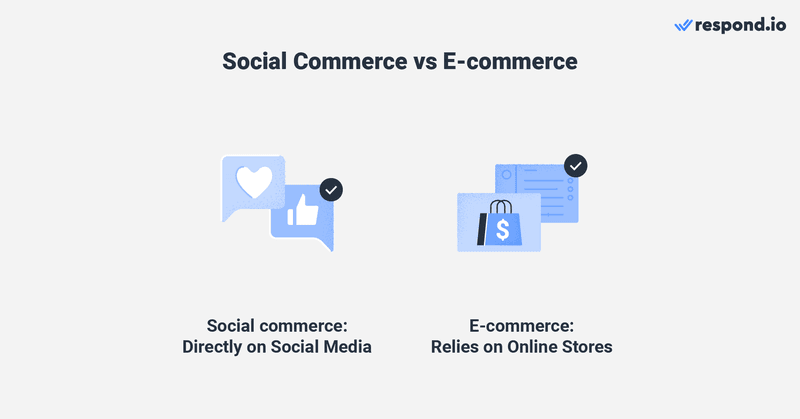
Some popular social commerce platforms include WhatsApp, Facebook Messenger, WeChat, LINE, and Instagram. These platforms have recognized the potential to monetize their vast user base by offering integrated shopping experiences.
For instance, Instagram's Shop feature enables businesses to showcase and sell products directly within the app, while WeChat's mini-programs allow users to browse and purchase items without leaving the messaging platform.
In recent times, messaging channels have also jumped into the e-wallet trend, bridging the gap between social media platforms and online stores even more. Some examples are Facebook Pay and WhatsApp Pay by Meta.
With this in mind, let's delve into the reasons why adopting a social commerce strategy has become increasingly beneficial for businesses and consumers alike
Benefits of Social Commerce
Here are three reasons why businesses are using it to elevate their online presence and drive more sales:
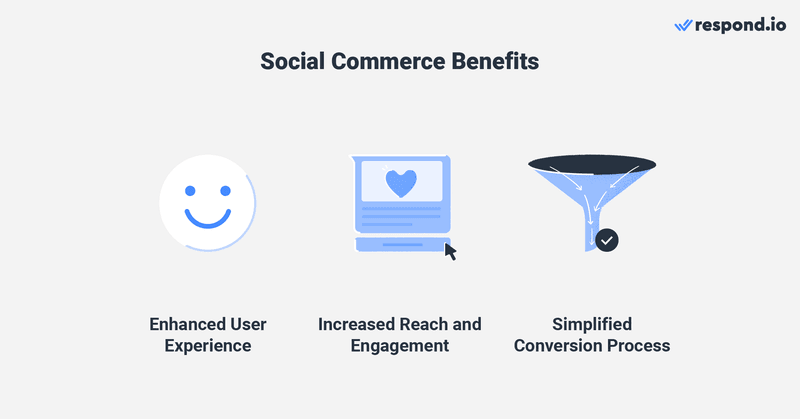
- Enhanced user experience: Social commerce provides a seamless and personalized shopping experience within the familiar environment of social media. Users can discover products through recommendations, reviews, and influencers they trust, creating a sense of authenticity and fostering engagement.
- Increased reach and engagement: Businesses can tap into the massive user base and high engagement levels of social media platforms. Social commerce allows for greater visibility, as users can easily share products or recommend them to their networks, amplifying brand exposure and generating organic growth.
- Simplified conversion process: Social commerce streamlines the buying process, reducing friction and increasing the likelihood of conversion by allowing users to make purchases directly within the social media platform.
Having explored the benefits, let's shift our focus to examine practical instances where businesses have leveraged this approach to drive their online presence and increase sales.
Examples of Social Commerce Strategies
While more and more businesses are gradually embracing this trend, we have selected two specific cases to showcase the transformative impact it can have on business growth and success.
Social Commerce Instagram: How Glossier Does It
Glossier is a cosmetics and skincare company that has gained significant popularity on its social commerce platforms, engaging customers and driving sales.
Glossier's strategy revolves around creating a strong online community and producing user-generated content. It has built a highly engaged following on platforms like Instagram, where it showcases products and encourages customers to share their own experiences and photos using branded hashtags.

Additionally, Glossier uses social commerce platforms as a direct sales channel. It has a seamless shopping experience integrated into their social media accounts, allowing users to browse and purchase products without leaving the platform.
Glossier also implements influencer marketing strategies, collaborating with popular beauty influencers to promote their products and reach a wider audience.
Social Commerce Instagram: How Fashion Nova Does it
Fashion Nova's strategy centers around influencer marketing and user-generated content. It collaborates with a wide range of celebrities, fashion bloggers, and social media influencers who promote their products on platforms like Instagram.
These celebrities often share photos and videos of themselves wearing Fashion Nova outfits, creating a desire among their followers to purchase the same items. Most importantly, Fashion Nova implements social media advertising and retargeting campaigns to reach their target audience.
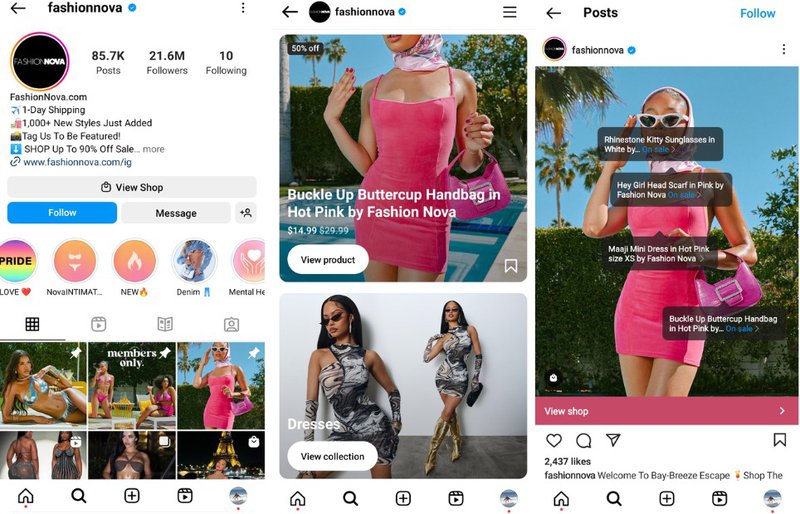
It also utilizes social commerce platforms like Facebook, Instagram, and Snapchat to target users who have shown an interest in fashion and related topics. By displaying personalized ads and retargeting users who have engaged with their brand, Fashion Nova maximizes its chances of converting social media users into customers.
If you’ve found these success stories inspiring, keep reading. We’ll share how you can use respond.io to implement a social commerce strategy for your own business and achieve similar results.
Why Use Respond.io as a Social Commerce Platform
By integrating your messaging channels with respond.io, you’ll transform your customer communication experience. Here are some best practices to optimize your strategy with respond.io.
A Single Inbox for All Social Commerce Platforms
Respond.io supports popular channels such as WhatsApp, Facebook Messenger, WeChat, LINE, and Instagram, all in one place. Businesses can answer customer inquiries from different messaging channels from an omnichannel inbox.
The convenience of managing multiple channels in one place simplifies customer communication and saves time. But when adopting an omnichannel approach, it is common to end up with siloed conversations across multiple channels.
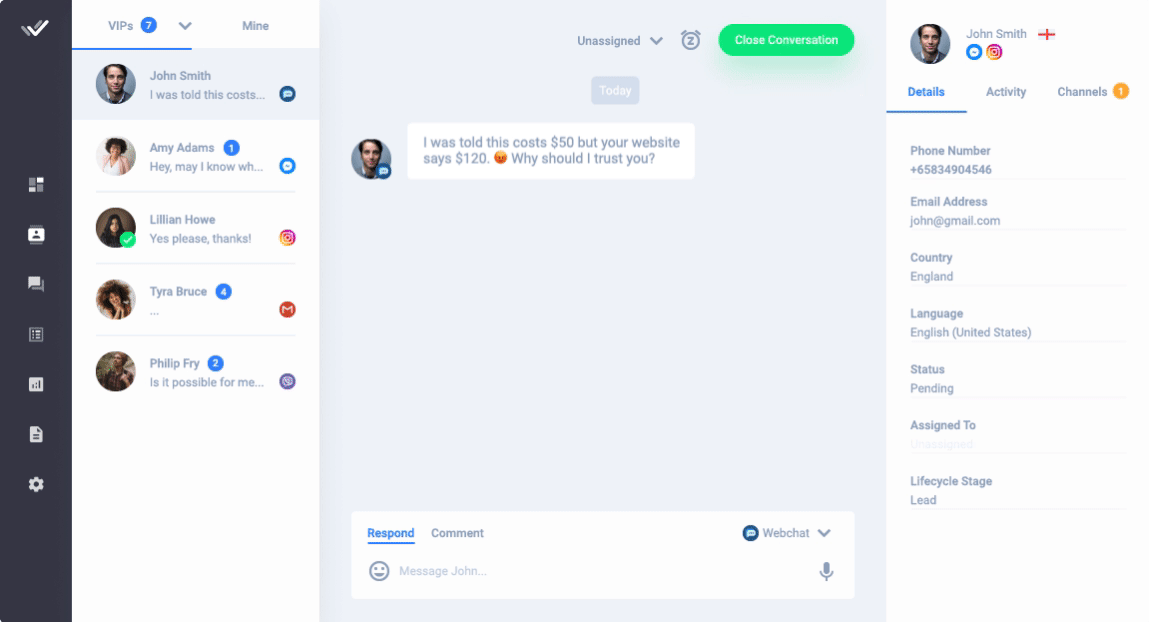
Respond.io's Contact Merge feature provides businesses with a holistic customer view by consolidating customer conversations into a single profile.
This unified view enables businesses to understand customer preferences, history, and behavior, ensuring a personalized and consistent experience throughout the customer journey.
Advanced Automation with Workflows
The Workflows Module is respond.io’s automation builder, designed to streamline company tasks with little to no agent input. Businesses doing social commerce can use Workflow to automate many of their processes.
To create the best first impression, build a welcome message Workflow to greet new customers that start a conversation with you. To manage response times expectations when there are no available agents, you can build an away message Workflow.

When done manually, conversation routing and agent assignment take valuable agent time and are not always consistent. Instead, try building a Workflow to route conversations to your customer-facing teams using your preferred routing logic.
On a similar note, create your own automatic assignment logic to distribute inbound conversations within teams with efficiency.
Some businesses based on consultations or services benefit from collecting customer information before the conversation. For such cases, businesses can easily create pre-chat surveys with the Ask a Question Workflow Step.
Agent Performance Monitoring with Advanced Analytics
Respond.io’s Reports Module enables businesses to monitor agents' performance through advanced analytics. Businesses can use it to track response times, resolution times and other key performance indicators.
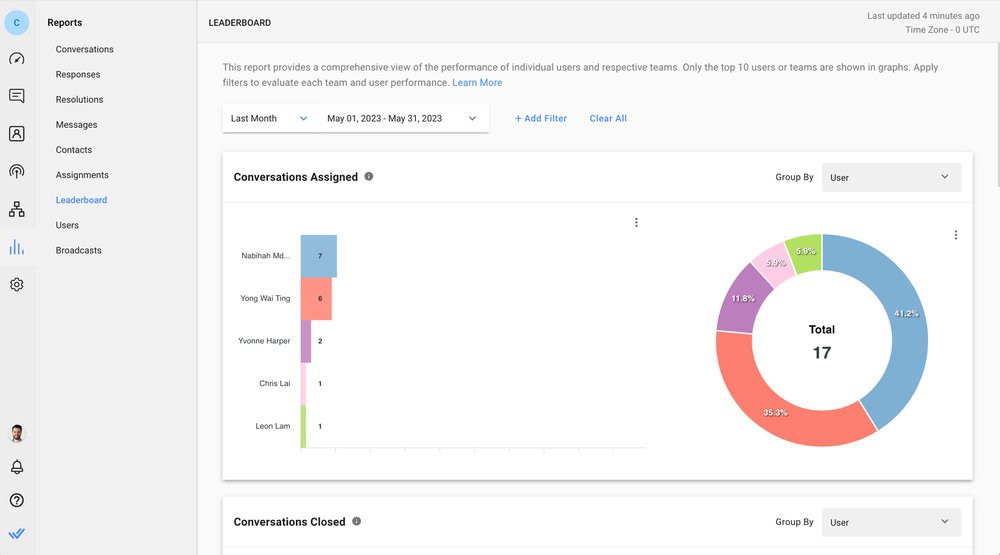
Most importantly, the Contacts tab in the Reports Module displays several leaderboards with a user-friendly interface. With the help of filters, you can get granular insights into your company teams and users.
Link Generation for Seamless Redirection
Respond.io allows businesses to generate links for different business messaging channels such as Instagram DM, WhatsApp or Facebook Messenger. Once created, these links can be shared across social media platforms.

By leveraging link generation, businesses can prompt conversations and increase conversions from their social media effortlessly.
Integration with External Platforms
Respond.io features native integrations with Zapier and Make.com — the two most popular software for app integrations, letting businesses integrate with a plethora of e-commerce platforms and CRMs.
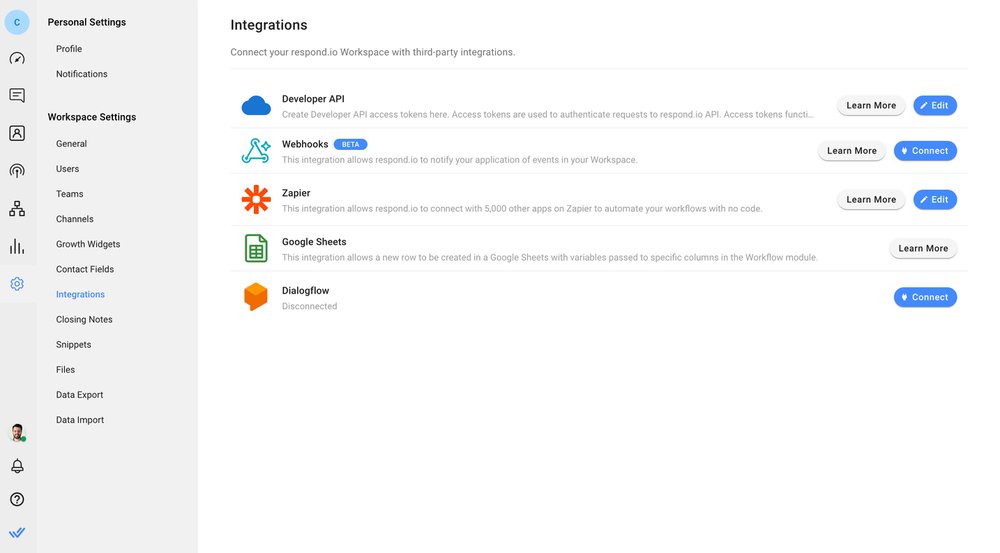
This integration capability allows businesses to seamlessly share data between respond.io and other platforms, ensuring smooth information flow, streamlined operations and cohesive customer experiences.
In conclusion, social commerce has emerged as a game-changer in the business world, enabling companies to connect with customers, drive conversions, and foster brand loyalty like never before.
With respond.io, you can unlock the full potential of this innovative trend and revolutionize your customer communication. Ready to get started? Sign up for a free trial and witness respond.io’s benefits firsthand.

Further Reading
Want to know more about business messaging? Here are some readings that might interest you.
- Conversational Commerce: A Guide to Conversational Commerce Platform
- How to Use an Omnichannel Retail Strategy to Drive Engagement and Sales
- Conversational Support: How it Improves Customer Experience




